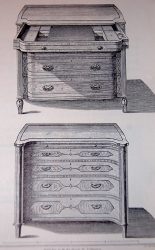Thomas Sheraton – Bridge to the Regency
Thomas Sheraton – Bridge to the Regency
By Hannah Crouthamel on Jul 30 in Furniture Designers
Thomas Sheraton, though a journeyman cabinet maker when he arrived in London in 1790, is not known to have had a workshop. It is believed he earned a bare living by working as a free  lance designer to other cabinet makers in London. He died in 1806 leaving “his family, it is feared, in distressed circumstances” (that according to “Obituary with Anecdotes of Remarkable Persons” in the Gentleman’s Magazine, Nov. 1806) . His designs are categorized as late Georgian, but they definitely presage the nascent Regency period in England and helped, as well, to define the Federal period in America.
lance designer to other cabinet makers in London. He died in 1806 leaving “his family, it is feared, in distressed circumstances” (that according to “Obituary with Anecdotes of Remarkable Persons” in the Gentleman’s Magazine, Nov. 1806) . His designs are categorized as late Georgian, but they definitely presage the nascent Regency period in England and helped, as well, to define the Federal period in America.
Sheraton Design Innovations
Sheraton’s designs are generally distinguished by his emphasis on carving and wood turning. To some extent it might be said tht he took some of the Hepplewhite shapes and instead of using inlay as the primary enrichment, he used carving.
But, he also explored and developed new shapes and treatments. The square shape of chair backs; the columnar or turned leg with spiral carving; the leg that stands proud of the carcass of various forms of furniture; the reeding carved into edges and turnings; the convex shape that is often used in case pieces; and the elaborate carved cross stretcher are some of the notable Sheraton innovations (more…)


